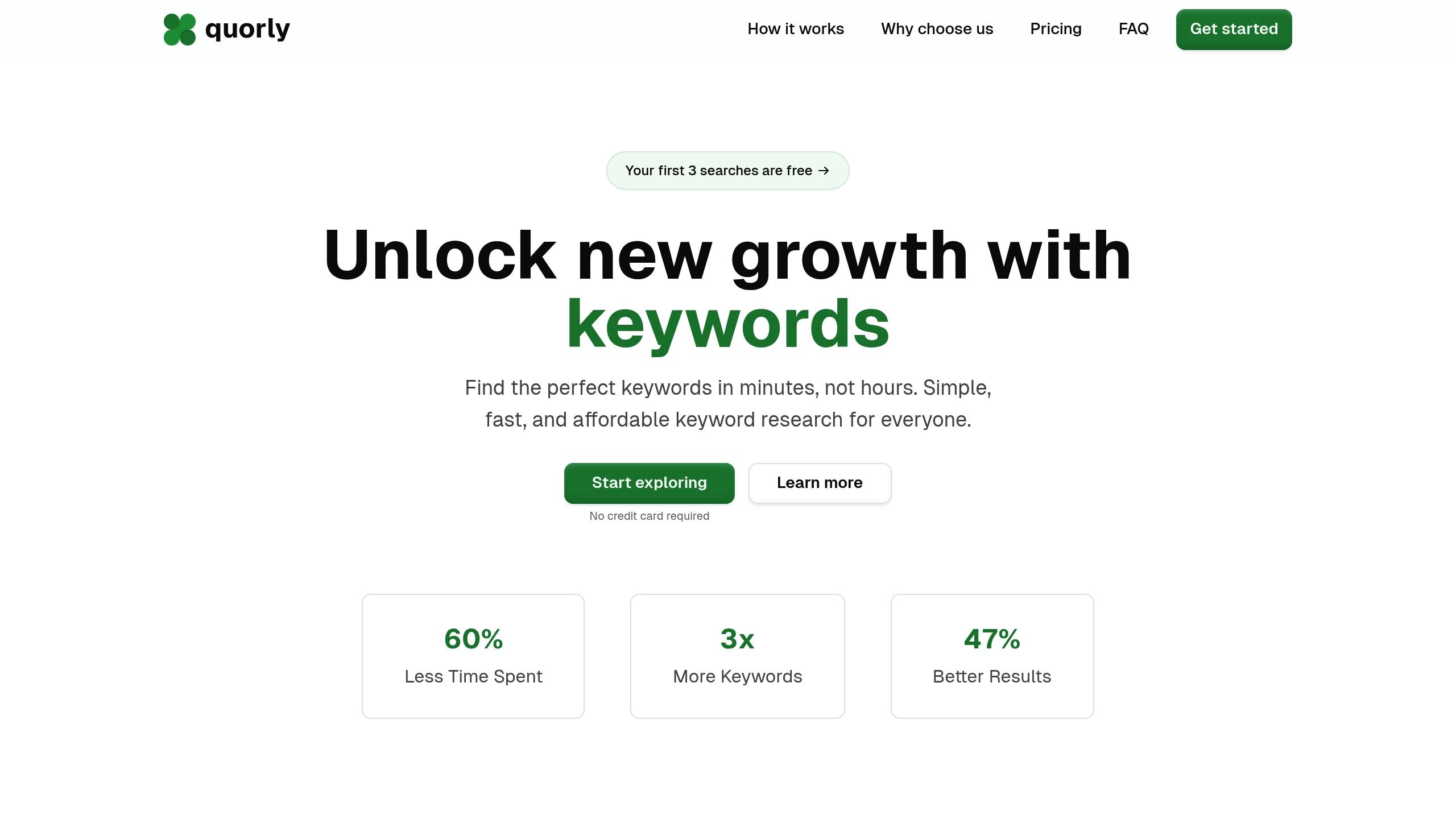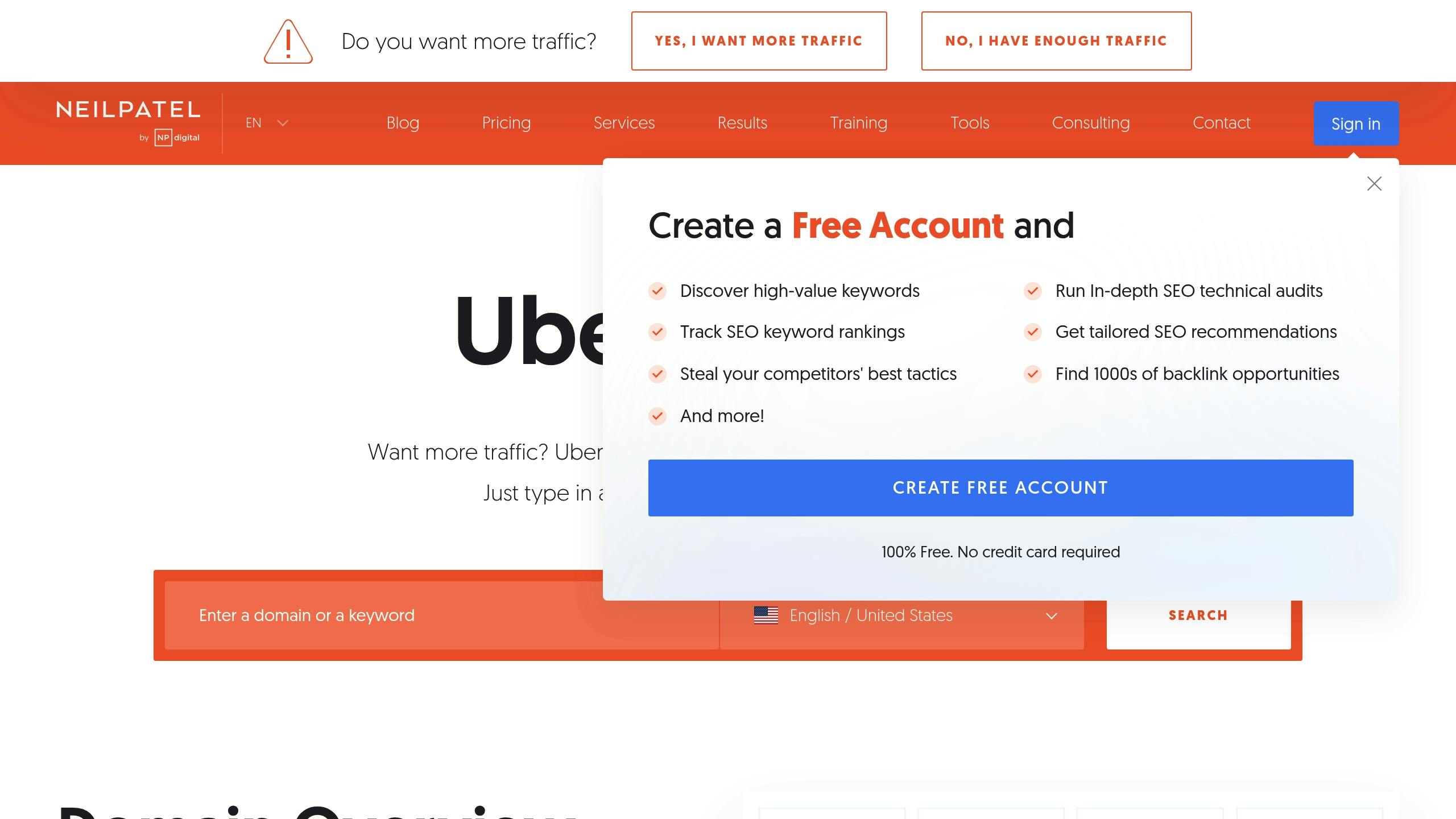
How to Find Low-Competition Keywords for Better Rankings
May 9, 2025
Low-competition keywords are your shortcut to better rankings and organic traffic. Instead of fighting over high-traffic terms, focus on specific, easier-to-rank phrases. Here's the gist:
-
What Are Low-Competition Keywords?
Keywords with low difficulty scores (KD under 15 for new sites, under 30 for medium authority) and less competition. Example: Instead of "best bakery", try "best gluten-free cupcakes in [your town]." -
Why They Work:
Easier rankings, targeted traffic, and higher conversion rates. Studies show targeting multiple low-volume keywords can match the traffic of one high-volume keyword. -
How to Find Them:
Use tools like Quorly, Ahrefs, or Ubersuggest to analyze KD scores, search volume, and competition. Focus on long-tail keywords and question-based terms. -
Quick Tips for Success:
- Target KD 0–10 for new sites.
- Align keywords with user intent (e.g., "how-to" guides for informational searches).
- Analyze competitors to spot overlooked opportunities.
How To Uncover Low Competition Long-Tail Keywords For SEO Like A Pro
Measuring Keyword Competition
To identify the best keywords for ranking, it's essential to analyze key factors that influence competition. This process involves assessing Keyword Difficulty (KD) scores and search volume, helping you pinpoint opportunities for success.
Keyword Difficulty Scores Explained
Keyword Difficulty (KD) scores gauge how tough it is to rank on Google's first page for a specific term. These scores range from 0 to 100, with each range offering insights into the level of competition:
- 0–5: Extremely easy to rank
- 30–49: Moderate competition
- 90+: Highly competitive and challenging
Several factors influence KD scores, including the number of backlinks, domain authority, search volume, SERP features, branded terms, and the length of the keyword itself [2].
Search Volume vs. Competition Metrics
Search volume often aligns with competition levels. According to Semrush, keywords with higher search volumes tend to have higher difficulty ratings. For example, keywords with over 100,000 monthly searches average a 76% difficulty score, while those with 11–100 monthly searches average just 39% difficulty [2].
Take these examples:
- "iPhone 15 Pro Max": With 823,000 monthly searches, it has a 71% difficulty score.
- "iPhone 15 Pro Max 256gb natural titanium": A more specific keyword with only 390 monthly searches but a much lower difficulty score of 38% [2].
This comparison highlights how long-tail keywords - more detailed and specific phrases - can provide better ranking opportunities, especially for smaller or newer sites.
| Search Volume Range | Average Difficulty | Best For |
|---|---|---|
| 100,000+ | 76% | Established sites with high authority |
| 1,000–10,000 | 45% | Medium-authority sites |
| 11–100 | 39% | New or smaller websites |
When analyzing keywords, it's also worth considering Semrush's competitive density metric, which measures advertiser competition on a scale of 0.0 to 1.0. Keywords with scores above 0.8 are highly competitive for paid advertising [1]. For organic rankings, aim for keywords with KD scores below 49% to improve your chances [1].
Tools for Finding Easy-to-Rank Keywords
Finding low-competition keywords becomes much simpler when you have the right tools in your corner. These tools can help you uncover keyword opportunities that are less competitive and more likely to boost your rankings.
Finding Keywords with Quorly

Quorly's AI-driven keyword discovery tool is designed to make finding low-competition keywords a breeze. It combines search volume data with competition analysis to give you actionable insights.
Here’s how to use Quorly for keyword research:
- Start with seed keywords
Begin by entering your main topic or a general idea into Quorly's search bar. The platform’s AI will generate a list of related keyword suggestions tailored to your input. - Apply competition filters
Use the competition analysis feature to filter keywords by their difficulty levels. By focusing on those with lower competition, you improve your chances of ranking higher. - Evaluate the keywords
Review the suggested keywords to ensure they align with your content goals. You can also use CPC (Cost Per Click) data to assess their commercial potential.
For a deeper dive into keyword metrics, Ahrefs is another powerful tool to consider.
Keyword Analysis in Ahrefs

Ahrefs provides detailed insights into keyword difficulty and ranking potential. Its Keyword Difficulty (KD) score is particularly helpful, as it indicates how challenging it might be to rank for a specific keyword based on your website’s current authority.
"Low-competition keywords are keywords that you can rank for without much effort. You usually won't have to build many links or have high website authority (Domain Rating) to rank for them and get organic traffic to your website."
– Joshua Hardwick, Head of Content @ Ahrefs
If you’re just starting out, aim for keywords with a KD score between 0 and 10. As your site builds authority over time, you can gradually expand to target keywords with higher difficulty levels.
For uncovering even more keyword opportunities, Ubersuggest is another excellent option.
Keyword Research in Ubersuggest

Ubersuggest is a handy tool for identifying content gaps and analyzing competitor keywords. Here’s what you can do with it:
- Find keywords that your competitors rank for but you haven’t targeted yet.
- Analyze user intent by reviewing the top-ranking content for specific keywords.
- Assess keyword opportunities by examining search volume and competition metrics.
sbb-itb-9ad1bd7
Analyzing Competitor Keywords
Once you've completed your keyword research, the next step is to analyze your competitors. This helps you identify gaps in their strategies and uncover low-competition keywords that could give you an edge.
Analyzing Top-Ranking Content
Start by focusing on competitors with a domain authority similar to yours. This ensures you're targeting keywords where you have a realistic chance of ranking. Take a close look at their high-performing content. Is it well-structured? Does it provide enough detail? Most importantly, does it align with the search intent of the audience?
"Competitor keyword analysis can guide your entire SEO strategy - it spots methods competitors use to hit the top spots on the search engine results pages, the topics they have the most authority in, and whether there are any weak spots you could fill in." - Horea Matei, Content writer @Surfer [4]
Here's an example of how this works in practice: The Roaming Renegades travel blog identified a specific keyword, "lake komani ferry", which had lower competition compared to the broader "lake komani" topic dominated by heavyweights like Wikipedia and Tripadvisor. By targeting this niche keyword, they managed to rank well in search results [4].
To take your analysis further, focus on question-based keywords that address specific user queries.
Finding Question Keywords
Question-based keywords are a goldmine for creating content that directly answers user needs. Here's how you can find them using tools like Quorly:
-
Start with Seed Keywords
Enter your main topic into Quorly's search bar and apply the Questions filter. This will highlight question-based keywords with lower competition scores. -
Understand Search Intent
Look at the types of questions users are asking and craft detailed, helpful answers. For instance, The Penny Hoarder climbed to the third spot in search results for "part-time jobs with immediate health insurance" by addressing a specific user query [4]. -
Evaluate Competition Levels
Use Quorly's competition analysis to find question keywords with:- Low difficulty scores (aim for under 10)
- Decent search volume
- Clear commercial intent, if relevant
"Knowing your competitors' keywords is the easiest form of keyword research. If your competitors rank for or target particular keywords, it might be worth it for you to target them, too." - Si Quan Ong, Content marketer @Ahrefs [3]
Selecting the Best Keywords
Once you've identified low-competition keywords, the next step is choosing ones that can drive the most traffic. Look for a sweet spot between high search volume, low competition, and clear user intent.
Matching Keywords to Content Types
To make the most of your keywords, align them with the right content formats. Here's a quick guide:
| Keyword Intent | Best Content Types | Example Keywords |
|---|---|---|
| Informational | How-to guides, tutorials, blogs | "how to make sourdough bread", "what are NFTs" |
| Commercial | Product reviews, comparisons | "best wireless earbuds 2025", "iPhone vs Android" |
| Transactional | Product pages, landing pages | "buy wireless earbuds", "iPhone 15 Pro price" |
| Navigational | Homepage, service pages | "facebook login", "amazon prime" |
To match keywords effectively:
- Analyze SERP results to see which content types Google prioritizes for your chosen keyword.
- Focus on the three Cs:
- Content type: Is it a blog post, product page, or video?
- Content format: Should it be a how-to guide, listicle, or review?
- Content angle: What unique perspective or selling point can you offer?
Once you’ve matched keywords to content types, it’s time to estimate their traffic potential.
Estimating Traffic Results
Estimating traffic potential helps you prioritize which keywords to target first. Here’s how to do it:
- Focus on low KD (Keyword Difficulty) scores - aim for keywords in the 0-10 range [5].
- Compare your site’s authority to the top-ranking pages for those keywords.
"Keyword competition is relative. Because no keyword difficulty score takes everything that affects competition into account, you should always manually review the top-ranking pages before creating content." [5]
When evaluating traffic potential, consider these factors:
- Click-through rates (CTRs): How likely is it that users will click on your content compared to competitors?
- Seasonal trends: Does search volume fluctuate throughout the year?
- SERP features: Are there featured snippets or other elements that might impact your visibility?
Conclusion
To wrap things up, achieving sustainable rankings requires a well-thought-out approach, especially when targeting low-competition keywords. The key lies in using the right tools, conducting thorough analysis, and aligning your efforts with your website's authority. By focusing on keywords with a difficulty score between KD 0-10, you can uncover opportunities that lead to measurable results.
However, keyword difficulty scores alone aren't enough. A manual review of top-ranking pages is crucial to understand what works and craft content that directly addresses user needs. Incorporating link-worthy content can also elevate your domain's authority, making future rankings more attainable.
"Keyword competition is relative. Because no keyword difficulty score takes everything that affects competition into account, you should always manually review the top-ranking pages before creating content."
- Joshua Hardwick, Head of Content @ Ahrefs
Here’s a streamlined approach to ensure success:
- Start with broad topic brainstorming.
- Use tools like Quorly for keyword discovery.
- Identify terms with low difficulty.
- Evaluate competitor backlink profiles.
- Develop content tailored to user intent.
Consistency is the backbone of long-term success. Regularly track competitors, refresh your content, and refine your strategy based on performance metrics. By following these steps, you'll be well-prepared to seize keyword opportunities that fuel organic traffic growth.
FAQs
What’s the best way to find and use low-competition keywords to boost website traffic and conversions?
To increase your website’s traffic and conversions, zero in on low-competition keywords - those specific, often long-tail phrases that are easier to rank for and bring in a well-targeted audience. These keywords not only enhance your visibility on search engines but also attract users who are more likely to take action, like signing up or making a purchase.
Here’s how to find them:
- Leverage keyword research tools to spot terms with lower difficulty scores.
- Examine search intent to ensure the keywords match what your audience is actively seeking.
- Analyze competitors to find overlooked opportunities within your niche.
Once you've pinpointed the right keywords, focus on crafting high-quality, relevant content that directly addresses user needs. By strategically incorporating these terms into your pages, you can improve your rankings and drive traffic that truly matters.
How can I use Quorly to find low-competition keywords for better search rankings?
To find low-competition keywords using Quorly, start by exploring its keyword research tools to compile a list of terms that are relevant to your niche. Look for keywords that strike a balance between low competition and moderate to high search volume - these are often the sweet spot for driving traffic.
Once you have your list, dig into the search intent behind each keyword. Make sure they align with what your audience is actively searching for and the kind of content they expect to find. This step ensures your efforts resonate with your target group.
Lastly, take advantage of Quorly’s competitor analysis features. These tools can help you spot gaps in your competitors' content strategies and reveal opportunities they might have overlooked. By combining these insights, you’ll be able to create a keyword strategy that not only boosts your rankings but also attracts the right audience to your site.
How can analyzing competitor keywords help me find low-competition keywords for my content strategy?
Analyzing competitor keywords can be a game-changer for your content strategy. By examining the keywords your competitors are ranking for, you can pinpoint gaps in their content or areas they haven’t fully optimized. These gaps often highlight keyword opportunities that may align perfectly with what your audience is searching for.
This approach doesn’t just help you create more targeted content - it also allows you to focus on less competitive keywords, increasing your chances of ranking higher in search results. It’s a smart, actionable way to refine your strategy and attract more organic traffic to your site.
More Articles

May 9, 2025
7 Keyword Research Tips for Small Business SEO
Learn essential keyword research strategies for small businesses to improve SEO, attract local customers, and boost online visibility.

May 8, 2025
Understanding Search Volume: A Beginner's Guide
Learn how to effectively analyze search volume for keywords to improve your SEO strategy and increase site traffic.